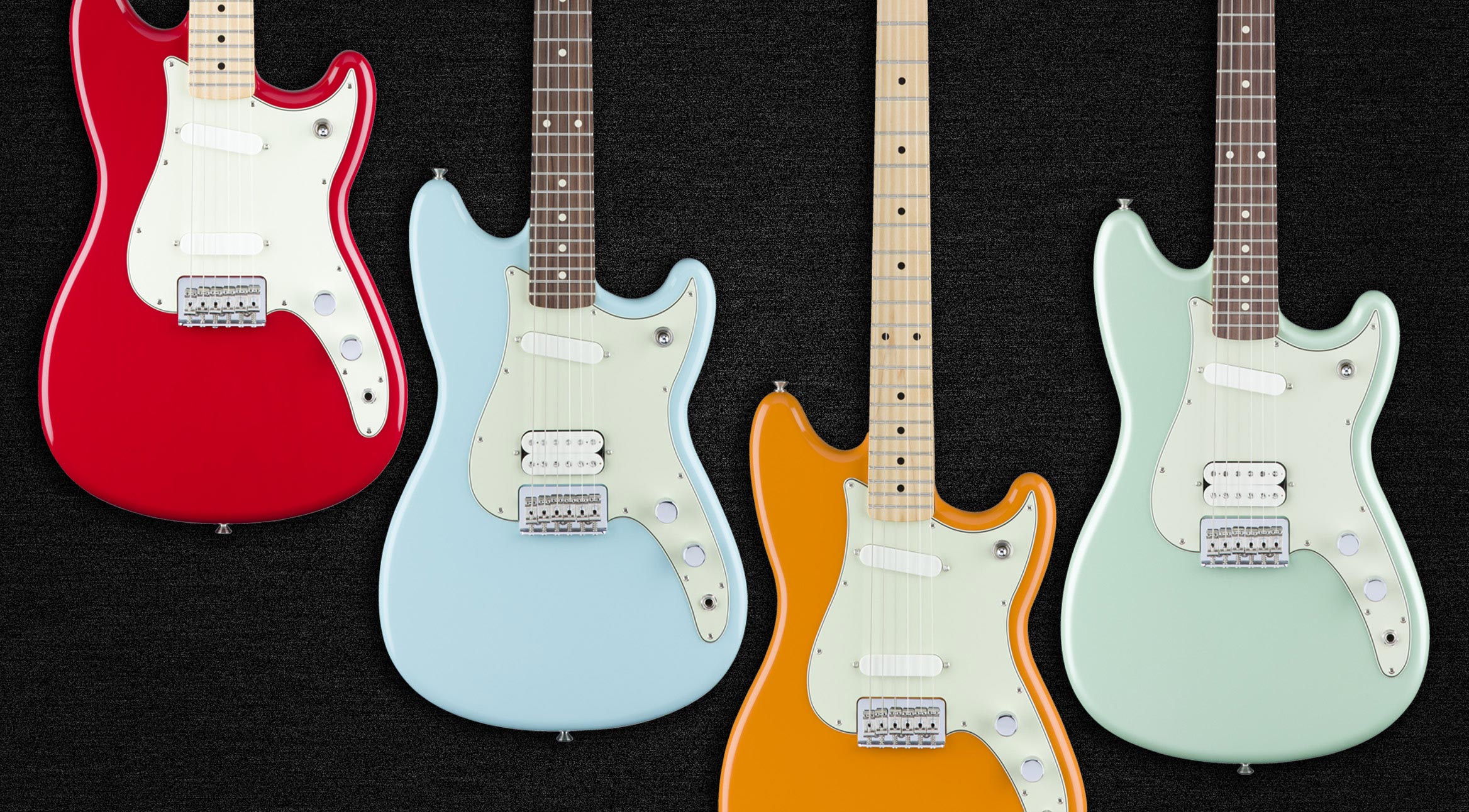3 Min ReadBy Jeff Owens and Mike DuffyShare
From Jimi to Indie: History of the Musicmaster and Duo-Sonic
How Fender's original short-scale models went from students to legends.

THE RUNDOWN
Not only did the Musicmaster and Duo-Sonic firmly establish Fender's tradition of student-model guitars in the 1950s, they also became favorites of several indie rock and alternative artists many years later. So yes, they certainly started many a beginner on their artistic path, but fans have likely seen them in the hands of players like Mickey "Dean Ween" Melchiondo of Ween, Dweezil Zappa and Liz Phair. Even Jimi Hendrix played one early in his career.
So what's the story behind these student-focused stalwarts? Dive into the history of the Fender Musicmaster and Duo-Sonic below.
THE GUITARS
Both original models were short-scale guitars—22.5 inches compared to 25.5 inches for the Telecaster and Stratocaster—with slightly smaller bodies, Strat-like headstocks and single-coil pickups.
The Musicmaster came first by a couple of months. The first production run had ash bodies, with black paint on their aluminum pickguards. June 1956 saw the second production run of Musicmasters and the first Duo-Sonic models, which were distinguished by an additional single-coil pickup at the bridge position.
Throughout the years, the Musicmaster and Duo-Sonic were offered in various body and pickguard colors, but the biggest change occurred in 1964, when they underwent a Mustang-like redesign complete with offset waists.
In the fall of 2016 the Duo-Sonic was reintroduced—alongside the Mustang—featuring a 24-inch scale, a modern "C"-shaped neck and two single-coil pickups. It is also available as a Duo-Sonic HS, which features a rosewood fingerboard and exchanges the single-coil bridge pickup for a humbucker with coil-split capability.

THE PLAYERS
Artists who’ve wielded Musicmaster and Duo-Sonic guitars include:
Jimi Hendrix, who played a 1959 or 1960 Duo-Sonic when he backed up the Isley Brothers during a 1964 tour
David Byrne, who largely used a Duo-Sonic on the Talking Heads’ first two albums, Talking Heads: 77 and More Songs About Buildings and Food
Rory Gallagher, who had a 1978 Duo-Sonic that saw frequent action on the road around ’82
Mickey “Dean Ween” Melchiondo, who favored a pair of Musicmasters throughout Ween's lengthy career
Liz Phair, who even featured her 1969 white Duo-Sonic on the cover of her self-titled 2003 album
Patti Smith, Tom Verlaine, Richard Lloyd, Dweezil Zappa and Johnny Winter
THE FULL STORY
The tradition of offering student-model guitars began almost as soon as Leo Fender founded the company in 1946. During that first decade, he and his sales chief, Don Randall, believed in “step-up” sales programs in which students and other beginners could follow a well-defined path of upgraded instruments as their skills grew.
Randall in particular was keen on the benefits of offering smaller, less-expensive student instruments to retailers who offered in-store music instruction; the thinking being that such dealers were well placed to launch beginners to the next level by selling them full-size Fender guitars. That continued with the Musicmaster and Duo-Sonic.
The Telecaster (1951) and Stratocaster (1954) were aimed at professionals, but for years there were no related student guitars to naturally lead beginning players to them.
Furthermore, a little thing called rock and roll was taking hold in popular culture. After all, “Rock Around the Clock” by Bill Haley & His Comets spent most of summer 1955 on top of the charts. Needless to say, a lot of kids were interested in electric guitar.
Randall urged Leo Fender to develop a student electric model around this time, and Leo responded with the Musicmaster and Duo-Sonic, which went into production in April and June of 1956, respectively.
With the widespread popularity of the vibrato-equipped Mustang, the Duo-Sonic was discontinued in 1969. The Musicmaster stayed, remaining in the Fender lineup until 1982 (and joined by the Musicmaster Bass model of 1971-1981).
It’s worth noting that while the Musicmaster and Duo-Sonic were smaller student models aimed at beginners, in no way were they lacking in the quality present in Fender’s pro-level instruments. They were well-designed, solidly built and highly affordable guitars. Perhaps that's a big reason why they were favored by so many indie artists who played them throughout the years. And of course, there was Hendrix with his Duo-Sonic before he became known as a Stratocaster man.
Fender offered a reissue Duo-Sonic from 1994 to 1998 that came in Black, Arctic White and Torino Red finishes. A Squier Affinity series Duo-Sonic model was introduced in 1998 and lasted for one year. A decade later, in 2008, Squier introduced the Classic Vibe Duo-Sonic ’50s model, which was much closer to the original 1950s design, with a Desert Sand finish and gold anodized aluminum pickguard (although it had a 24-inch scale rather than the original 22.5-inch scale). It was discontinued in early 2013.
Now, the 24-inch scale Duo-Sonic lives on in Fender’s Offset Series, which was released in late 2016. The new Duo-Sonic comes in Arctic White, Capri Orange and Torino Red finishes, while its sibling, the Duo-Sonic HS, appears in Daphne Blue, Black and Surf Green colorways.
Featured Collection





